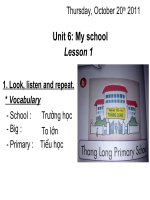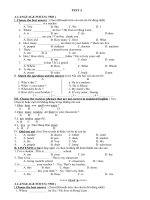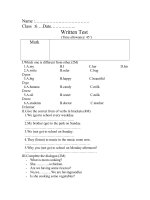unit 1 greetings tiếng anh 6 sách cũ nguyễn xuân thiển thư viện giáo án điện tử
Bạn đang xem bản rút gọn của tài liệu. Xem và tải ngay bản đầy đủ của tài liệu tại đây (477.85 KB, 13 trang )
<span class='text_page_counter'>(1)</span><div class='page_container' data-page=1>
The week :…….
The period:……
The teaching date:………….
<b>INTRODUCING SUBJECT AND HOW TO LEARN</b>
<b>I.Objective</b>: <b> </b>
* Sau khi học xong bài học, học sinh sẽ có thể:
- Biết cách học Tiếng Anh
- Nắm được sơ qua nội dung chương trình tiếng Anh 6
- Biết được đặc trưng của mơn học để có biện pháp học nhằm đạt kết quả cao nhất.
<b>II. Giới thiệu chương trình Ti ế ng Anh 6 </b>
<i><b>1. Mục tiêu mơn học.</b></i>
- Hình thành và phát triển ở học sinh những kiến thức, kỹ năng cơ bản về Tiếng Anh và
những phẩm chất trí tuệ cần thiết để tiếp tục học hoặc đi vào cuộc sống lao động.
- Học sinh có thể nắm được kiến thức cơ bản tối thiểu và tương đối hệ thống về Tiếng
Anh thực hành hiện đại.
- Có kỹ năng cơ bản sử dụng tiếng Anh như một công cụ giao tiếp đơn giản duới các
dạng nghe nói, đọc, viết.
- Có sự hiểu biết khái quát về văn hóa các nước sử dụng Tiếng Anh
- Hình thành kỹ năng học tiếng và phát triển tư duy, phát triển kỹ năng sử dụng tiếng
mẹ đẻ và góp phần hình thành ngơn ngữ tồn diện hơn cho học sinh
<b>III. Giới thiêu sách Tiếng Anh 6 </b>
<i><b>1.Cấu trúc sách</b></i>
- Có 16 đơn vị bài học(Units)
- Mỗi đơn vị bài học gồm 3 phần A,B,C
- Sau 3 bài học cĩ 1 phần Grammar Practice và 1 bài kiểm tra 45’
- Cuối sách là phần tổng kết ngữ pháp và từ vựng cả năm học
<b>2.Phân phối chương trình</b>
Cả năm: 3 tiết x 37 tuần = 111
Học kỳ I: 3 tiết x 19 tuần = 57 tiết / Học kỳ II: 3 tiết x 18 tuần = 54 tiết
<b>IV. Giới thiệu cách học Tiếng Anh </b>
<i><b>1.Trên lớp:</b></i>
- Trật tự lắng nghe giáo viên giảng bài, hăng hái phát biểu ý kiến
- Rèn luyện và giao tiếp bằng Tiếng Anh trong giờ học T-A, hạn chế sử dụng Tiếng
Việt
- Mạnh dạn phát âm chuẩn, thực hành nói nhiều
<i><b>2.Học ở nhà</b></i>
- Học bài cũ: học từ vựng, ngữ pháp của bài học trước .Đọc lại bài khóa nhiều lần để
nhớ từ vựng .Tự lấy ví dụ sử dụng cấu trúc ngữ pháp đã học .Làm nhiều bài tập nâng
cao .Chuẩn bị bài học tiếp theo (Tra từ vựng của bài học, đọc trước bài học phát triển 4
kỹ năng: nghe, nói, đọc, viết.) . Giao tiếp với khách nước ngồi nếu có cơ hội
<b>V. </b>
<b> Dặn dò</b>
1. Học thuộc bài học
2 .Chuẩn bị Unit 1 – Greetings (Lesson1: A1,2,3,4)
</div>
<span class='text_page_counter'>(2)</span><div class='page_container' data-page=2>
The period:…… The teaching date:………….
<b> UNIT 1: GREETINGS</b>
<b> Lesson 1 : A1,2,3,4</b>
<b>I.OBJECTIVE:</b>
* By the end of the lesson, students will be able to :
- Greet each other
- introducing oneself
- Count and write numbers from 1 to 5 in English
* Education: know greet when meeting friends , teachers or connections
<b>II. LANGUAGE CONTENTS:</b>
<b>1 / Grammar</b>: My name is.../ I’m...
<b>2 / Vocabulary </b>:
(pro) I , my ,
(n) name , one ,two, three, four ,five
(inter) Hello, hi
<b>III. METHOD:</b>
- Audio- oral method , communicative approach
<b>IV. TEACHING AIDS:</b>
- pictures , cassette , tape , lesson plan , book , rule ,chalk
<b>V.SKILL: </b>
- Speaking and listening
<b>VI. PROCEDURES</b>:
1,Classroom order :1’
2,New lesson :
Time/step
s
Activities Content
Warm- up
4
<b>(Communicative approach)</b>
- T asks some questions in Vietnamese
? C¸c em gặp bạn mới trong lớp học của
mình, thì sẽ làm gì?
- Answer the Teachers questions in
vietnamese
- Xin chào .
- Giíi thiƯu tªn
Presentati
on
6’
Check
4’
<b>(Communicative approach , audio-oral </b>
<b>method)</b>
- T explains new words
- Ss listen to the teacher.
- Ss repeat after T twice
- Hello / Hi : (inter) <i>(Translation)</i>
- name (n) : <i> (Translation)</i>
- I : (pro) <i>(Translation)</i>
- my : (pro) <i>(Translation)</i>
<i>- am / is (tobe) (Translation)</i>
- Ss read Vocab chorally then individually
- T gives the meaning of the words .
- Ss copy down .
- T checks new words by : <b>“What and </b>
<b>Where”</b>
<b>A.1.2.3</b>
<b>I. Vocabulary</b>
- Hi / Hello: xin chào
- name: tên
- I : tôi
- my : của tôi
- am / is : là , thì, ở
<b>* What and Where</b>
hi hell
nam my
</div>
<span class='text_page_counter'>(3)</span><div class='page_container' data-page=3>
Presentati
on
5’
<b>(Communicative approach , audio-oral </b>
<b>method)</b>
+ T sets the scene : points to the picture
and asks in Vietnamese
(?) Đây là ai ? (<i>Lan) …</i>
“ Lan and Nga see each other for the first
time. How do they greet each other and How
do they introduce their names ?”
- Ss listen and repeat after the tape once
<b>II. Giới thiệu tên mình </b>
<b>a) I am + tên mình </b>
ex. I am Lan
b) My name is + tên mình
* Note :
My name = my name’s
I am = I’m
Check
3’
<b>(Communicative approach )</b>
- T asks ss to introduce their name
- T corrects
Practice
7’
<b>(Communicative approach )</b>
- Ask Ss to read the dialogues in silent
then practice in pairs in front of the
class
- T asks Ss to greet and introduce their
names to their classmates
- Ss work in groups (4 groups) then
present in front of class
- T listens and corrects
- T educates
<b>A4/P.11</b>
* Example Exchange
<i>Hoa: Hi. I am Hoa</i>
<i>Thu: Hi. I’m Thu</i>
<i>or</i>
<i>Hoa : Hello. My name is Hoa</i>
<i>Thu: Hello. My name is Thu</i>
<i><b>Moral lesson:</b></i> know greet when
meeting friends , teachers or
connections
Further
practice
6’
<b>(Communicative approach )</b>
- Elicit the numbers from the Ss
- T reads the number then writes them
on the board
- Ss read the numbers in chorus then
individual
- Ss write down
<b>* Numbers 1-> 5</b>
- One : 1
- two : 2
- three : 3
- four : 4
- five : 5
Productio
n
7’
- T uses the poster and asks ss to do
exercise
- Call on 2 students to go to the board
to fill in the gaps
- T corrects
- Slap the board
- Ss play in 2 groups ( A-B)
- Praise the winner
<b>* Gap- filling</b>
a) Nam: Hello. My name is Nam
Phong: Hello. My name's<i><b> </b><b> </b><b> Phong</b></i>
a) Lan: Hi. I...am<i><b> .</b><b> .</b><b> Lan</b></i>
Ha: . Hi<i><b> . </b><b> ..</b><b> I’m Ha</b></i>
<b>* Slap the board</b>
<b>* Homework ( 2’ )</b>
- Learn by heart Vocab , numbers and practice how to introduce the name
- Say greetings to the members of your family
- Prepare A5,6,7
* <b>Experience : </b>
………
….
………
….
The week :…….
2
1 4
</div>
<span class='text_page_counter'>(4)</span><div class='page_container' data-page=4>
The period:……
The teaching date:………….
<b> UNIT 1: GREETINGS</b>
<b> Lesson 2 : A5,6,7</b>
<b>I.OBJECTIVE:</b>
* By the end of the lesson, students will be able to :
- Ask and answer about the health as greeting.
- Count and write numbers from six to ten
* Education: know greet when meeting friends , teachers or connections
<b>II. LANGUAGE CONTENTS:</b>
1 Grammar:
- to be (is/am/are)
- how are you ?
2 Vocabulary:
(a)fine
(n) thanks , six , seven , eight , nine , ten
<b>III. METHOD:</b>
- Audio- orall method , communicative approach
<b>IV. TEACHING AIDS:</b>
- Pictures , cassette , tape , lesson plan , book , rule , chalk, gap fill chart
<b>V. SKILL: </b>
- listening , speaking and writing
<b>VI. PROCEDURES</b>:
1,Classroom order :1’
2,New lesson :
Time/steps Activities Content
Warm- up
3’
<b>(communicative approach)</b>
- Ask pairs of sts go to the board
to greet and introduce themselve
- T corrects
* Example:
<i>- S.1: Hello, I am Hoa</i>
<i>- S.2: Hi, My name is Lan.</i>
Presentation
( 7’ )
Checking
<b>(communicative approach, Audio- </b>
<b>orall method)</b>
+ <b>Presentation Dialogue </b>
- T sets the scene: <i>“Ba and Lan are </i>
<i>meeting and greeting each other</i>
<i>How do they ask about their health?”</i>
-- Let’s listen to their dialogue.
- Ss listen to the dialogue once
- Elicit the new words from the
students
- Fine (adj) : toát, khỏe <i>(Situation)</i>
- Thanks : cảm ơn (<i>Situation)</i>
- Miss : cô (chưa có gđ) <i>(Translation)</i>
- Mr: ông <i> (Translation)</i>
<i>- you : (Situation)</i>
<i>- fine (Situation)</i>
- Ss read Vocab chorally
<b>A.5</b>
<i><b>* Dialogue.</b></i>(p.12)
<i><b>1.Vocabulary</b></i>
- how (pro)
- are (tobe)
- you (pro)
- thanks / thank you (n)
- fine (adj)
</div>
<span class='text_page_counter'>(5)</span><div class='page_container' data-page=5>
2’ individually
<b>* Checking Vocab.</b>
- T reads Vietnamese words , Ss
read English words and inverse
-T corrects
Presentation
3’
Check
2’
<b>(communicative approach)</b>
- T introduces the sentence
patterns about the health
- T writes them on the board
- Ss write down
- T explains the phrase “<i>and you</i>”
- T asks the question some Ss
answer then a student and an
other answer
- T remarks and corrects
<i><b>2. Ask and and the health</b></i>
- How are you?
-> I’m fine , thanks . And you ?
Practice
4’
<b>(communicative approach, Audio- </b>
<b>oral method)</b>
- Ss listen the dialogue(A5) twice
- Listen and repeat following the
tape (twice)
- Some pairs practice aloud.
- T corrects
* <i><b>* Dialogue.</b></i>(p.12)
<i><b>* Moral lesson:</b></i> know greet when
meeting friends , teachers or
connections
Practice
( 6’ )
- Ask Ss to work in pairs to make
two similar dialogues as the
dialogue between Ba and Lan.
- Get Ss to play the role of Miss
Hoa and Mr .Hung ; Nam and
Nga to pratice the dialogue
- T and and good student model
first
- Ss work in pairs: open pairs -
closed pairs
- Ss practice in front of the class
- T remarks and corrects
<b>A.6</b>
<b>* Example Exchange</b>
<i>- Miss Hoa: Hello. Mr Hung</i>
<i>- Mr Hung: Hello, Miss Hoa</i>
<i>- Miss Hoa: How are you?</i>
<i>- Mr Hung: I am fime, thanks. And you?</i>
<i>- Miss Hoa: Fine, Thanks</i>
Production
( 3’)
<b>(communicative approach )</b>
- Have Ss to read the dialogue
between Nam and Lan then fill in
the gaps with suitable words ( T
uses the poster)
- Ss write the completed dialogue
on the board
- T corrects
- T asks Ss to great , introduce
their name and ask the health in
their situations
- T and and good student model
first
- T corrects
<b>A.7 </b>
<b>* Grap – fill </b>
- Nam : Hello <i>Lan</i>
How <i>are you ?</i>
- Lan : Hi, I’m <i>fine, thanks .</i>
<b>* Example exchange</b>
<i><b>T</b> : Hi , I am thuong </i>
<i><b>S </b>: Hello , I am Nam </i>
<i><b>T </b>: How are you ?</i>
<i><b>S</b> : I am fine , thanks . And you ?</i>
<i><b>T</b>: fine , thank you .</i>
</div>
<span class='text_page_counter'>(6)</span><div class='page_container' data-page=6>
Purther
practice
4’
<b>(communicative approach )</b>
- T introduces numbers from six
to ten
- T reads the number then writes
them on the board
- Ss repeat after teacher
- Ss read the numbers in chorus
then individual
- Ss write down
<b>* Numbers 6</b><b> 10</b>
- six = 6
- seven = 7
- eight = 8
- nine = 9
- ten = 10
Check
2’
<b>(communicative approach )</b>
<b>- Checking : </b>matching
- T instructs then model
- Ss go to the board to do the
matching
- T corrects
* Matching
1.six a.8 1……
2.ten b.6 2…….
3.eight c.9 3…….
4.seven d.10 4……..
5.nine e.7 5……..
Practice
3’
<b>(communicative approach )</b>
- Ask Ss to listen and write down
numbers they have heard
- Call on Ss to read numbers
- T corrects
3776672
3527914
8217326
8565656
Production
3’
<b>(communicative approach )</b>
- Slap the board
- Ss play in 2 groups ( A-B)
- T praises the winner
<b>* Slap the board</b>
<b>* Home work : (2’)</b>
- Learn by heart the Vocab , numbers , sentence pattern about the health
- Prepare: B1-6
<b>*</b> <b>Experience</b>:
……….
………
….
ho
7
3 ar
8
yo 9
</div>
<span class='text_page_counter'>(7)</span><div class='page_container' data-page=7>
The week :………
The period :……
The teaching date:………….
<b> UNIT 1: GREETINGS</b>
<b> Lesson 3 : B1,2,3,4</b>
<b>I.Objective:</b>
* By the end of the lesson, students will be able to:
- greet each other by using “good morning, good afternoon, good evening, good night.”
- use “ We are....” to talk about us
- count and write numbers 11<sub></sub>15
* Education: know greet when meeting friends , teachers or connections
<b>II. LANGUAGE CONTENTS:</b>
<b>1, Vocabulary </b>:
(phra) Good morning, good afternoon, good evening, good night, good bye
(n) children , mom , (pro) we
<b>2, Grammar :</b>
(review) how are you ? -> we are fine
<b>III. METHOD :</b>
- audio- oral method , communicative approach
<b>IV. TEACHING AIDS:</b>
- pictures , cassette , tape , lesson plan , book , rule ,chalk , gap fill chart
<b>V. SKILL: </b>
- Listening , speaking and writing
<b>VI. PROCEDURES</b>:
1,Classroom order :1’
Time/steps Activities Content
Warm- up
6’
<b>(communicative approach )</b>
- Call pairs of sts go to the board and
practice greeting , introducing their
name and ask the health with each
other.
- T reads the number and ask sts to
write in words on the board
- T corrects
<b>* Example </b>
<i><b>T</b> : Hi , I am thuong </i>
<i><b>S </b>: Hello , I am Nam </i>
<i><b>T </b>: How are you ?</i>
<i><b>S</b> : I am fine , thanks . And you ?</i>
<i><b>T</b>: fine , thank you .</i>
Presentation
( 10’ )
<b>(communicative approach )</b>
- Elicit the new words from the
students (using pictures and
explanation)
- Good morning:<i> ( buổi sáng 0h <sub>– 12</sub>h<sub>)</sub></i>
- Good afternoon:<i> buổ chiều 12h <sub>– 18</sub>h<sub>) </sub></i>
- Good evening:<i>( buổi tối từ 18h <sub>– 22</sub>h<sub>)</sub></i>
- Good night: <i>tạm biệt trước lúc ngủ</i>
- Good bye/ bye<i>: tạm biệt</i>
- Children: <i>trẻ con </i>
- We (pro) : <i>chúng tôi/ta</i>
- T guides Ss to read the Vocab Ss
<b>B.1</b>
<i><b>1.Vocabulary</b></i>
</div>
<span class='text_page_counter'>(8)</span><div class='page_container' data-page=8>
Check
3’
read the chorally, individually
- T explains some ways of greeting
- Ss take notes
*<b> Check :</b> T reads in English
- Ss read in Vietnamese
- T corrects
- Good night: <i>chúc ngủ ngon</i>
- Good bye/ bye<i>: tạm biệt</i>
- Children: <i>trẻ con</i>
- We (pro) : chúng tôi/ta
* Notes
<i>- Hi/ hello: Lời chào thân mật không </i>
<i>phân biệt thời gian trong ngày.</i>
<i>- Good morning/ afternoon/evening: </i>
<i>dùng để chào tùy theo thời gian trong </i>
<i>ngày thể hiện sự trịnh trọng, lịch sự để </i>
<i>tôn trọng người đối thoại.</i>
Practice
( 5’ )
<b>(communicative approach )</b>
<b>* Picture Drill </b>
- Run through the pictures.
- Ss look at the pictures and repeat
after the teacher.
- Let students identify the differences
between the pictures
- Ask them to practice in pairs
in front of class
- Correct if there are any mistakes.
<b>B.2</b> / p.15
<i> 1 2 3 4</i>
<i>- Good morning</i>
<i>- Good afternoon</i>
<i>- Good evening </i>
<i>- Good night</i>
Presentation
(5’ )
<b>(communicative approach )</b>
+ Show the picture in B3/P.15 and
introduce : “This is Miss Hoa and these
are children . Miss Hoa comes in the class
How do Miss Hoa and the students greet
one another?Let's listen to their dialogue”
- Ss listen to the tape twice
- Ask Ss to play the role of Miss Hoa
and the children to read the
dialogue(closed pairs)
- some pairs of Ss to demonstrate the
dialogue before the class
- T reviews the question and the
answer.
- Ss take notes
- Ss listen to the tape(dialogue B3b)
<b>B.3/</b>P.15
* Dialogue B.3a (p/15)
<i>Notes</i>
How are you?
We are fine, thank you
=> We’re = We are
* Dialogue B.3b (p/15)
Practice
5’
- Ask Ss to play the role of Lan’s
mother and Lan to read the
dialogue(closed pairs)
- some pairs of Ss to demonstrate the
dialogue before the class
- T corrects
Production
( 3’ )
<b>(communicative approach )</b>
- Ask Ss to work in pairs to complete
the dialogue B4/p.16.
- Ask students to play the role of Lan
and Nga
- T corrects .
<b>B4/ p.16</b>
</div>
<span class='text_page_counter'>(9)</span><div class='page_container' data-page=9>
*<i><b>Good class</b></i>: ask ss to make a similar
dialogue to B4 with their books close
Nga<i>: I am fine, thanks.</i>
<i>And you?</i>
Lan<i>: Bye</i>
Further
practice
5’
<b>(communicative approach )</b>
- T introduces Number from 11 to 15
- Ss read Vocab, chorally then
individually
<b>* Checking</b> :
- T reads in English
- Ss read in Vietnamese
<b>* </b>Numbers 11<sub></sub>15
<b>-</b> eleven:11
<b>-</b> Twelve:12
<b>-</b> thirteen:13
<b>-</b> fourteen:14
<b>-</b> fifteen: 15
<b>* Homework ( 2’ )</b>
1. Learn by heart the Vocab
2. Prepare: C 1-2
<b>* Experience: </b>
………
………
The week :…….
The period:……
The teaching date:………….
<b> UNIT 1: GREETINGS</b>
<b> Lesson 4 : C1,2 How old are you ?</b>
<b>I.OBJECTIVE:</b>
* By the end of the lesson, students will be able to :
- review the number from one to fifteen .count and write numbers from 16 to 20 in
English
* Education : Advise ss to count exactly when they learn Math or count something<i>…</i>
<b>II. LANGUAGE CONTENTS:</b>
1, Vocabulary:
- sixteen, seventeen <b> , </b>eighteen<b> , </b>nineteen<b> , </b>twenty
2, Grammar :
<b>III. METHOD:</b>
- audio- orall method , communicative approach
<b>IV. TEACHING AIDS:</b>
- pictures , cassette , tape , lesson plan , book , rule ,chalk , drawing
<b>V-SKILL: </b>
- Speaking and listening
<b>VI. PROCEDURES</b>:
1,Classroom order :1’
2,New lesson:
Time/steps Activities Content
Warm- up
3’
<b>(Communicative approach)</b>
T: Ask ss to greet each other and
ask – answer about the health.
</div>
<span class='text_page_counter'>(10)</span><div class='page_container' data-page=10>
T: remark, and give marks.
Presentation
11’
<b>(Communicative approach)</b>
- T introduces the lesson.
- T reviews cardinal numbers from
one to fifteen and introduces
numbers from sixteen to twenty
- Let ss listen to the tape and repeat
twice.
- Ask some ss to read aloud.
T remarks.
- Ss write down
- T introduces structures with
numbers
<b>C.1</b>
<b>1 Number:</b>
One:1 seven:7 thirteen: 13
two:2 eight:8 fourteen: 14
three:3 nine: 9 fifteen: 15
four:4 ten:10 sixteen:16
five:5 eleven: 11 seventeen: 17
six: 6 twelve: 12 eighteen: 18,
nineteen: 19 twenty: 20.
- and (conj) cộng
- minus (v) trừ
<b>2 Structures:</b>
- One and two is three.
- Three minus two is one
Check
4’
<b>(Communicative approach)</b>
- T instruct ss how to play.
- Ss play in groups.
- T remarks.
<b>* Slap the board</b>
<b> </b>
Practice
12’
<b>(Communicative approach , audio- </b>
<b>orall method )</b>
-Ask sts to work in pairs ,count
from one to twenty
Ask ss to count:
+ even numbers: 2, 4, 6, ….. 20.
+ odd numbers: 1, 3, 5,7,………19
* Oral practice:
T – S; S – S;.
20 minus 12 = ?ten and ten =?
19 minus 5 = ? five and six = ?
13 minus 4 = ? eight and three = ?
- Ss answer. T remarks
- Then T asks Ss to count the
number from one to twenty (not
looking at the book )<b> </b>
- T corrects
<b>C.2</b>
Further
practice
7’
<b>(Communicative approach)</b>
- T ask sts to play a game: one read
the number and the other write that
number in word, from one to twenty
- T corrects
Production
5’
<b>(Communicative approach)</b>
- Ss play games
- T shows ss how to play the game.
- Ask whole class to join
* Noughts and crosses.
19 15 8
5 14 12
7 3 13
20 18
14
1
9
15
</div>
<span class='text_page_counter'>(11)</span><div class='page_container' data-page=11>
- T remarks and corrects
<b>* Homework ( 2’ )</b>
1. Learn by heart numbers,
3. Prepare C5-6 /P. 19(text book)
<b>* Experience:</b> ……….
………
The week :…….
The period:……
The teaching date:………….
<b> UNIT 1: GREETINGS</b>
<b> Lesson 5 : C3,4,6</b>
<b>I.Objective:</b>
* By the end of the lesson, students will be able to :
- Ask and answer about age
- Introduce the other
* Education: advise ss should make friends one another and help them in their study
<b>II. LANGUAGE CONTENTS:</b>
1, Vocabulary:
2, Grammar:
- Tobe : is / am / are
- How old + be + S ? -> S + be +……( years old).
- This is …
<b>III. METHOD:</b>
- audio- orall method , communicative approach , inductive method
<b>IV. TEACHING AIDS:</b>
-pictures , cassette , tape , lesson plan , book , rule ,chalk ,
<b>V-SKILL: </b>
- Speaking and listening
<b>VI. PROCEDURES</b>:
1,Classroom order :1’
2,New lesson :
Time/steps Activities Content
Warm- up
6’
<b>(communicative approach)</b>
* Check the old lesson:
- T: Ask ss to count from 1 to 20.
- T: remarks and gives marks
- Ss work in groups.
- T remarks
<i>*Game: chain game:</i>
<i>Ex 1: one, two, three…</i>
<i>Ex 2: two, four, six ……</i>
<i>Ex3: one, three , five…</i>
Presentation
13’
<b>(inductive method , communicative </b>
<b>approach)</b>
<b>- </b>T asks Ss to look at the picture C.3
( p. 18/book) and Presents the
dialogue:
<i>“Miss Hoa, Lan and Hoaand Nga are </i>
</div>
<span class='text_page_counter'>(12)</span><div class='page_container' data-page=12>
<i>greeting one another. Nga introduces Lan to </i>
<i>Miss Hoa. How Miss Hoa asks about Lan’s </i>
<i>age. Let's listen their dialogue”</i>
-Ss listen the dialogue C3 and find out
model sentences
- T introduces the new structures by
giving Ex or using situation in the
dialogue C3 P 18.
Ex: This is Nga ( T points to Nga (<i>a </i>
<i>student in the class )</i>
- T notes the questions : how are you ?
and how old are you?
- Ss listen and repeat after the tape
twice
- Ss listen and write down
<b>1, Ask and answer about age</b>
<b>a, </b>Ex:
- How old are you?
-> I'm twelve (years old)
b, Form :
- How old + be + S?
-> S + be +…( year old).
Note :
- How old…? bao nhiêu
tuổi ?
- Year old : (n) tuổi
<b>2, Introduce the other</b>
* Ex : This is Lan
* Form : This is + name
* note : This : (pro) đây / này
Check
4’
<b>(communicative approach)</b>
- T asks some questions about the age
- Ss aswer about their age .
- T corrects
Practice
13’
<b>(communicative approach)</b>
- Let ss listen to the tape and repeat
twice.
- Let ss role play the dialogue.
- Ss work in triad ( group ) as told.
- Ask some groups to role play.
- T gives feedback.
- T instructs ss how to practice ex.4
P19.
- Ss work in pairs as told.
- T goes round to help ss and check ss’
work.
- Ask some pairs to ask – answer.
- T gives feedback.
- Let ss play bingo in C5 P 19. T shows
ss the way to play. Ss play. T remarks
<b>C.4 : </b>Practice:
Ex:
<i>A: How old are you?</i>
<i>B: I am 12 years old</i>
C5 Bingo P 19
Production
7’
<b>(communicative approach)</b>
- Ss work in pairs and in triad:
introduce others and ask–answer about
their age.
- Ss practice as told. T remarks
<b>* Good class:</b>
- T asks ss to contrast between <i>“How</i>
<i>are you?</i>” and <i>“How old are you?”</i>
Ss answer.
- T remarks , educates
- T reminds ss again the two structures
above.
Ex:
S1:Hello,Minh. This is ( Mai)
S2:Hello,(Mai).How old are
you?
S3: I am ( eleven ).
<i>Moral lesson</i><b>: </b><i>Advise ss </i>
<i>should make friends one </i>
<i>another and help them in their</i>
<i>study</i>
</div>
<span class='text_page_counter'>(13)</span><div class='page_container' data-page=13>
- Ask students to learn by heart questions about the age and introduce the other
- do Ex C3 – 4 in the workbook
- Prepare U.2: (A1-A4).
<b>* Experience : </b>
………
….
………
….
………
….
………
….
<b>Duyệt của tổ chuyên môn ngày : </b>
Thank you for downloading my lesson plans of English 6.
Please visit my youtube with some clips to support the powerpoint
presentation plans at the link below.
/>
And my reference books website:
</div>
<!--links-->
<a href=' /> Bảng từ Unit 1 - 14 Tiếng Anh 6
- 8
- 817
- 0








